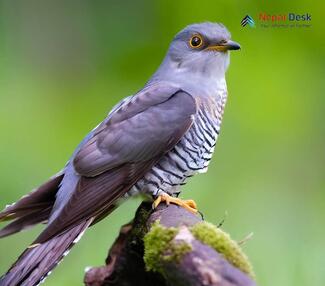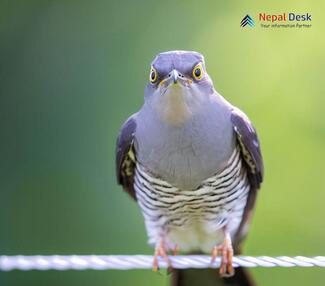The Common Cuckoo (Cuculus canorus) belongs to the cuckoo family of birds known as Cuculiformes, which also feature the roadrunners, anis, and coucals. Its scientific name is inspired by the Latin terms "cuculus" for cuckoo and "canorus" for melodious singing. The cuckoo family and genus names originate from the male common cuckoo's call, which imitates their sound. The term "cuckoo" dates back to Old French "cucu" and was first utilized in English around 1240 within the song "Sumer Is Icumen In," written in Middle English. The opening lines say, "Svmer is icumen in / Lhude sing cuccu," which means "Summer has arrived / Sing loudly, Cuckoo!" Nepal's incredible biodiversity offers a unique mix of bird species, including the fascinating Common Cuckoo. This enigmatic bird is known for its distinct song and unusual nesting habits and can be found across diverse habitats in Nepal.
In this article, we will explore the enchanting world of the Common Cuckoo in Nepal, focusing on its behavior, habitat, and importance in local culture.
A Unique Song that Resonates Across the Land
The Common Cuckoo (Cuculus canorus) is perhaps best known for its iconic two-note call "cu-coo," uttered by the male cuckoo during the breeding season. The familiar sound echoes throughout various parts of Nepal from forest edges to grasslands and even urban areas, announcing the arrival of spring and captivating bird enthusiasts and casual observers alike.
A Master of Deception and Brood Parasitism
One unique aspect of the Common Cuckoo's behavior is its practice of brood parasitism. Instead of building their own nests and nurturing their hatchlings, female cuckoos lay their eggs in the nests of other bird species. They cunningly choose nests with eggs that resemble their own both in size and coloration so as not to arouse suspicion.
Once a cuckoo chick hatches, it often pushes other eggs or hatchlings out of the nest to become the sole recipient of food and care from its unwitting foster parents. This remarkable adaptation has made the Common Cuckoo a fascinating subject for researchers and birdwatchers alike.
Habitats Abound: Where to Spot a Common Cuckoo in Nepal
In Nepal, the Common Cuckoo can be found across a range of habitats from lowland grasslands to subtropical broadleaved forests up to an altitude of around 2,500 meters. Prime locations for spotting them include Chitwan National Park, Annapurna Conservation Area, and Koshi Tappu Wildlife Reserve. These protected areas provide ample opportunities for birders and nature enthusiasts to catch a glimpse of this elusive songbird.
Cultural Significance and Conservation
The Common Cuckoo's enchanting call has garnered it cultural significance in Nepal, where it's locally known as the "Pape Kukhura." As a harbinger of spring, the cuckoo is often regarded with fondness and its song inspires many traditional poems and songs. However, like many species around the world, the Common Cuckoo is facing challenges due to habitat loss and climate change. Efforts are underway in Nepal to conserve habitats for various bird species, ensuring the captivating call of the cuckoo continues to grace the land for generations to come.
In conclusion, the Common Cuckoo stands as a remarkable example of avian biodiversity in Nepal. Its distinctive call and intriguing breeding habits make it a noteworthy subject for both birdwatchers and other nature enthusiasts. As we continue to learn more about this unique species, ongoing conservation efforts will help protect their habitats and secure their future within Nepal's rich ecosystem.




